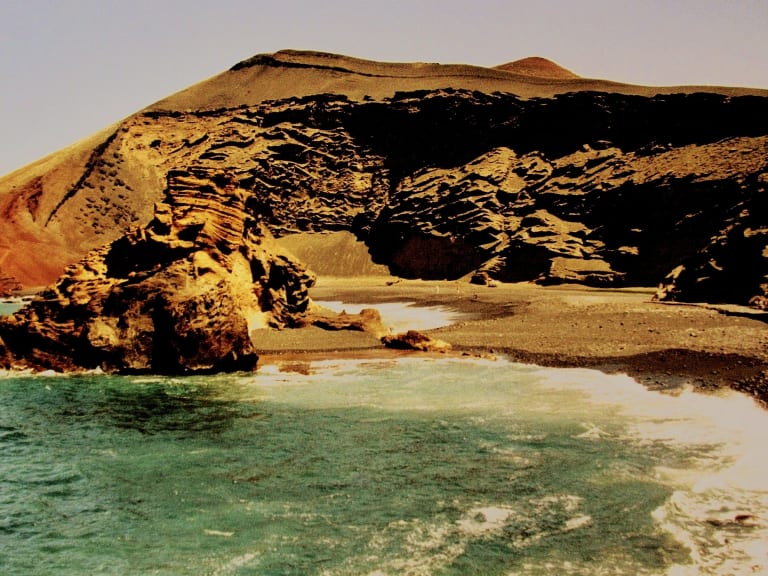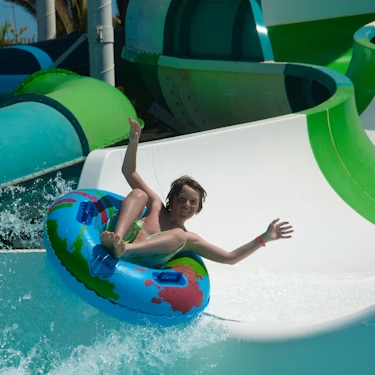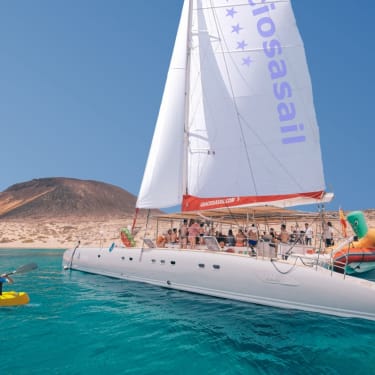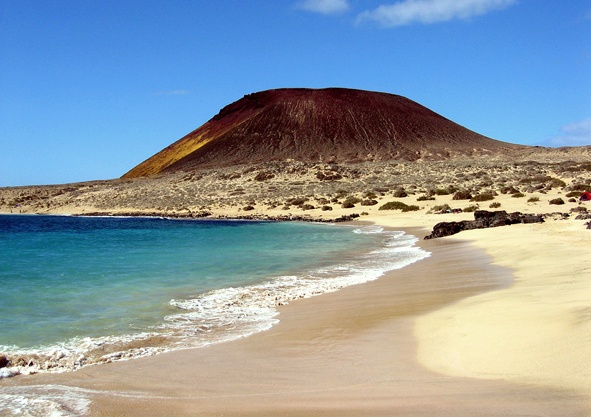More about: Lanzarote in 7 Days: a guidebook for getting the most out of your visit
One third of the island of Lanzarote was once covered with lava, which has given it a unique volcanic character. Between craters, clear sandy beaches, fishing villages and art integrated into nature, the island offers very different experiences in every corner. If you are thinking about what to see in a week, this itinerary is for you.
Day 1: Mirador del Río, La Graciosa Island and Órzola

Start the trip in the north, with panoramic views, quiet beaches and villages where the pace stops. From the Mirador del Río you will see the island of La Graciosa, where you can spend the day between sand and sea. Finish the tour in Órzola, perfect for dinner by the sea.
Viewpoint of the River
Located 400 meters above the sea, the Mirador del Río is a work of César Manrique that offers spectacular views of La Graciosa. Its architecture blends into the rock, and it has a cafeteria, binoculars and parking. You can also see the landscape for free from the nearby Mirador de Nahum.
La Graciosa Island
From Órzola you can take a ferry to La Graciosa, an island without cars or asphalt. Walk through its small village and enjoy the French beach, accessible by foot or by bike. You can also book an excursion from Lanzarote that includes a catamaran ride and lunch.
Caletón Blanco Beach
On the way back, stop at Caletón Blanco beach, with white sand, volcanic rocks and shallow waters. It is one of the best beaches to go with children and perfect for a last dip of the day.
Stroll around Órzola and taste its gastronomy
Órzola is a fishing village with white streets and quiet atmosphere. It is an ideal place to end the day tasting fresh fish or seafood in one of its restaurants by the sea.
Day 2: Jameos del Agua, Cueva de los Verdes and boat ride

Spend the day at two volcanic jewels of Lanzarote: Jameos del Agua and the Cueva de los Verdes. In the afternoon, relax with a sunset boat ride from Puerto del Carmen, a perfect way to see the coast from a different perspective.
Cave of the Greens
The Cueva de los Verdes is a volcanic tunnel that you can tour on guided tours. It has a natural concert hall and was intervened by César Manrique, who knew how to highlight its beauty with light and design.
Jameos del Agua
A few minutes away, Jameos del Agua is another section of the same volcanic tube, where you will find an interior lake, restaurant and spaces designed by Manrique that combine architecture and landscape.
Sunset boat ride
From Puerto del Carmen you can take a boat ride with snacks and a glass of champagne included. You will see cliffs and beaches from the sea, while enjoying the sunset.
Day 3: Timanfaya National Park

The third day is dedicated to the incredible volcanic landscape of Timanfaya National Park: craters, red rocks and lava fields that look like from another planet. Here you can also taste food made with the heat of the subsoil.
Mancha Blanca Interpretation Center
Before entering the park, visit this free center, where you will learn about the geological history of the area and the origin of the eruptions. Ideal as an introduction.
Hilario Islet
On the Islote de Hilario you will see geothermal demontrations, such as artificial geysers or stones burning on contact with the air. From here the Volcanoes Route starts.
Route of the Volcanoes in Timanfaya
This guided bus route takes you through the most spectacular corners of the park. The terrain is so fragile that it cannot be covered on foot.
Tremesana Trails
If you feel like walking, you can book a free walking route from the interpretation center. It is 2 km long and requires prior registration.
Day 4: Museum of the Atlantic and Papagayo Beaches

Today it's time to explore the south: dive among underwater sculptures at the Museo del Atlántico and then relax in the pristine coves of Los Ajaches Natural Monument.
Underwater Museum
The Museo del Atlántico can only be visited by diving. There are more than 300 sculptures under the sea, work of Jason de Caires Taylor. It is ideal to make your diving baptism.
Papagayo Beaches
The Papagayo beaches are coves of white sand and crystal clear water, connected by trails. You can also see the archaeological site of San Marcial Rubicon on the beach of El Pozo.
Day 5: Casa Museo del Campesino and wine route

This day is dedicated to local culture. Start at the Casa Museo del Campesino, and then tour some of the most representative wineries of the island.
Casa Museo del Campesino
The Casa Museo del Campesino was designed by Manrique as a tribute to the island's farmers. Here you can see traditional architecture, buy handicrafts or eat typical dishes.
Wine Route
The LZ-30 road connects wineries such as Los Bermejos, El Grifo and La Geria, where you can do tastings and learn about cultivation in volcanic soil.
Day 6: Art Museum and César Manrique Foundation

Today is art day. Visit the International Museum of Contemporary Art and then the César Manrique Foundation in Tahíche.
Museum of Contemporary Art
Located in an old castle, this museum houses works by Miró, Tàpies and Sempere, as well as a restaurant overlooking the sea.
César Manrique Foundation
Built on volcanic bubbles, the former home of Manrique is now a museum. You can combine the visit with a walk around Tahíche or visit the Casa Museo Haría.
Day 7: Charco de los Clicos, Los Hervideros and Salinas de Janubio

Close your itinerary in the southwest of the island with volcanic landscapes and unique natural phenomena.
Charco de los Clicos
This green lake, inside a volcanic crater, owes its color to sulfur and algae. You can see it from the viewpoint or walk to the shore.
The Hervideros
In this area of cliffs, the sea enters with force into lava tunnels, creating jets of pressurized water. It is an impressive natural spectacle.
Janubio Salt Flats
These historic salt mines have been active since 1895. In addition to producing salt, they form a photogenic landscape and are a protected area for birds.
















